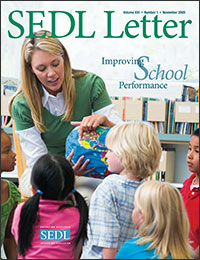Research Update: School Turnarounds
Statistics and studies indicate that improving student achievement in low-performing schools continues to be a challenge for states across the nation. Researchers and policymakers refer to schools that have low graduation rates and fail to meet academic benchmarks as indications of this ongoing struggle. In the 2005–2006 school year, for example, four of the nation’s five-largest school districts had an averaged freshman graduation rate (an estimate of the percentage of high school students starting at ninth grade who graduate on time with a regular diploma) of 55%, compared to a national average of 73% (Garofano & Sable, 2008).

Another measure of school performance is adequate yearly progress (AYP). AYP is a state’s measure of progress toward 100% of its students meeting the state academic achievement targets in reading/language arts and mathematics as defined in the No Child Left Behind Act of 2001 (NCLB). If a school fails to make AYP for 5 or more consecutive years, it must undergo restructuring. In the 2007–2008 school year, more than 3,500 schools were in the planning or implementation phases of restructuring, a 50% increase from the 2,302 schools reported for the 2006–2007 school year (Scott, 2008). These numbers have prompted education leaders to reexamine the most effective way to help low-performing schools. School turnarounds—implementing dramatic school interventions that lead to more expedient improvements than seen in the past—have emerged as a strategy for helping low-performing schools. Here, we summarize three research reports on school turnarounds that provide a conceptual framework and suggested actions for education leaders.
Recommendations Target Leadership, Instruction, and Staff
In the Institute of Education Sciences practice guide Turning Around Chronically Low-Performing Schools, Herman et al. (2008) identify four recommendations for school turnarounds:
- Signal the need for dramatic change with strong leadership.
- Maintain a consistent focus on improving instruction.
- Make visible improvements early in the school turnaround process (quick wins).
- Build a committed staff.
These recommendations, suggest the authors, can help educators quickly and dramatically improve student achievement in chronically low-performing schools. For each recommendation, the report summarizes the level of research evidence supporting it. The authors then provide case studies of schools to illustrate how to implement each recommendation. The report also provides a checklist for implementing the recommendations and discusses possible roadblocks and solutions for each one.
The authors based their recommendations in part on 10 case studies that looked at turnaround practices at 35 schools (21 elementary schools, 8 middle schools, and 6 high schools). For the purpose of the study, turnaround schools were defined as those that have shown a dramatic improvement in student outcomes over a short period of time. Consequently, the case studies focus on schools that improved student achievement in 1 to 3 years.
The report also includes secondary analyses of primary studies (school profiles) and identifies common strategies across successful turnaround schools. In addition, the authors drew information from a report on turnarounds with new leaders and staff, and incorporated evidence from business turnaround research.
The authors acknowledge that the research base on school turnarounds is limited, and the recommendations all rely on low levels of evidence as defined by the IES practice guide standards. According to the IES levels of evidence, “low refers to expert opinion based on research and theory on other topics and evidence from studies that do not meet the standards for moderate or strong evidence” (Herman et al., 2008, p. 3). The evidence supporting the recommendations includes expert analyses of turnaround practices, case studies of seemingly effective schools, and correlational and longitudinal studies of patterns of school improvement, all of which characterize the two other reports described in this article. The authors were unable to find any studies that met the What Works Clearinghouse’s (http://ies.ed.gov/ncee/wwc) high-quality experimental and quasi-experimental standards, which provide the strongest evidence of causal validity.
Key Actions of Successful School Leaders
In School Turnarounds: Actions and Results, Brinson, Kowal, and Hassel (2008) discuss what actions must take place and what new leaders must do for school turnaround to occur. The authors examine the five AYP restructuring options: (1) reopen the school as a public charter school; (2) replace all or most of the school’s staff; (3) contract with an outside entity to operate the school; (4) turn the operation of the school over to the state educational agency; or (5) implement another form of restructuring that makes fundamental reforms. They indicate that options 1, 3, and 4 rarely have been used; most states have chosen option 5 (another form of restructuring) rather than implement stronger interventions.
The authors state that in 2006, of those districts utilizing stronger interventions, 42% of states appointed an outside expert to advise the school, 24% extended the school day or year, and 14% restructured the internal organization of the school. Only 14% of schools undergoing restructuring replaced a large portion of the school’s staff, and almost none of the districts invited private firms or state agencies to take over schools or to reopen them as charter schools.
The report identifies 14 leader actions associated with successful school turnarounds:
- Collect and analyze data.
- Make an action plan based on the data.
- Concentrate on big, fast payoffs in Year 1.
- Implement practices even if they require deviation from the norms or rules.
- Require all staff to change.
- Implement necessary staff changes.
- Concentrate on successful tactics; discard others.
- Report progress but focus on high goals.
- Communicate a positive vision.
- Help staff personally feel problems.
- Gain the support of key influencers.
- Silence critics with quick success.
- Measure and report on progress often.
- Require all decision makers to share data and participate in problem solving.
The recommendations are based on qualitative research, primarily case studies, of organizations that have successfully turned around performance. Citing a limited body of research on school turnarounds, the authors augment research in their literature review with research about effective turnaround strategies and leaders in business, nonprofit, and government sectors.
The authors define a successful turnaround as a school that experiences significant gains in student learning in Year 1 and then sustains those gains over time. Although the literature the authors reviewed did not support this long-term view, it did indicate that researchers considered successful turnarounds to be schools that achieved AYP after failing to do so for 3 years prior to the turnaround efforts.
Learning From Past Successes and Failures
In The Turnaround Challenge, Calkins, Guenther, Belfiore, and Lash distinguish turnaround from school improvement by explaining that a school turnaround initiative “focuses on the most consistently underperforming schools and involves dramatic, transformative change” (2007, p. 10). They explore both the causes of school failure and strategies for rapid school improvement in their research. SEDL is working with state and district leaders who are at different points in the turnaround process. Program staff and researchers are helping schools to stay focused on improving instruction and identifying early improvements through SEDL’s Working Systemically approach to systemic improvement.
The authors’ research methodology includes a literature analysis; individual and group interviews with practitioners, researchers, leading policymakers, and reform experts in more than a dozen states; extensive interviews with directors of school intervention and school management and/or support organizations; and a review of the report’s major findings and recommendations by more than two dozen national reform leaders and project partners.
On the basis of their research, the authors identify three key elements for a comprehensive state turnaround initiative: changing conditions, building capacity, and clustering for support (Calkins et al., 2007, p. 12). Changing conditions refers to dismantling common barriers to reform through state intervention or measures taken by district leadership. To build capacity for effective school turnaround, the authors look to the state to take responsibility for providing the means and expertise. Finally, the authors argue that school turnaround cannot be accomplished in small numbers; rather, districts and states should undertake the effort in clusters of schools organized around needs, such as school type, student characteristics, feeder patterns, or region. The authors also provide a self-audit for states to measure the probable impact of their approach to school turnaround.
SEDL Supporting Turnarounds
| SEDL is working with state and district leaders who are at different points in the turnaround process. Program staff and researchers are helping schools to stay focused on improving instruction and to identify early improvements through SEDL’s Working Systemically approach to systemic improvement. The Working Systemically approach offers a way for all stakeholders—from the state level to the classroom—to identify and maintain focus on key academic goals. Although the Working Systemically approach emphasizes long-term improvements, the strategy offers a way for educators to create coherence in their work, align curriculum, and focus on improving school performance. SEDL’s Texas and Southeast Comprehensive Centers have both provided extensive professional development on the Working Systemically approach to state and regional leaders in the regions they serve. They have also provided resources and ongoing technical assistance to help leaders make crucial decisions as they implement the Working Systemically approach. During development of the Working Systemically approach, SEDL found mixed results for its outcomes across 16 districts in the Southwest. SEDL is currently collecting outcome data through intermediate units that are using the approach in several Texas districts, as well as from a few districts in Louisiana and South Carolina where SEDL is directly supporting its implementation. In addition, SEDL is helping states strengthen their statewide systems of support. These systems are state-led efforts to support schools in their improvement efforts. All states, however, are reaching a point with some chronically low-performing schools where they are exploring options like school turnarounds. SEDL staff are helping state and district leaders find more effective ways to strengthen their systems of support and identify turnaround strategies that can have a greater impact than traditional school improvement models. In May 2008, SEDL’s Southeast Comprehensive Center hosted a regional institute on turnarounds to help state education leaders better understand and apply the research. SEDL’s Texas Comprehensive Center, in collaboration with the Texas Center on District and School Improvement, will co-host a district symposium on school turnarounds on December 1–2, 2009. |
References
- Brinson, D., Kowal, J., & Hassel, B. (2008). School turnarounds: Actions and results. Lincoln, IL: Center on Innovation & Improvement. Retrieved from www.centerii.org
- Calkins, A., Guenther, W., Belfiore, G., & Lash, D. (2007). The turnaround challenge: Why America’s best opportunity to dramatically improve student achievement lies in our worst performing schools. Boston, MA: Mass Insight Education & Research Institute. Retrieved from www.massinsight.org/DownloadHandler.ashx?fn=~/resourcefiles/TheTurnaroundChallenge_MainReport.pdf
- Garofano, A., & Sable, J. (2008) Characteristics of the 100 largest public elementary and secondary school districts in the United States: 2005–06 (NCES 2008-339). Washington, DC: National Center for Education Statistics, Institute of Education Sciences, U.S. Department of Education. Retrieved from http://nces.ed.gov/pubs2008/100_ largest_0506/
- Herman, R., Dawson, P., Dee, T., Greene, J., Maynard, R., Redding, S., & Darwin, M. (2008). Turning around chronically low-performing schools: A practice guide (NCEE 2008-4020). Washington, DC: National Center for Education Evaluation and Regional Assistance, Institute of Education Sciences, U.S. Department of Education. Retrieved from http://ies.ed.gov/ncee/wwc/publications/ practiceguides/
- Scott, C. (2008). A call to restructure restructuring: Lessons from the No Child Left Behind Act in five states. Washington, DC: Center on Education Policy.
Next Article: Recovery 101: Stimulus for School Improvement

